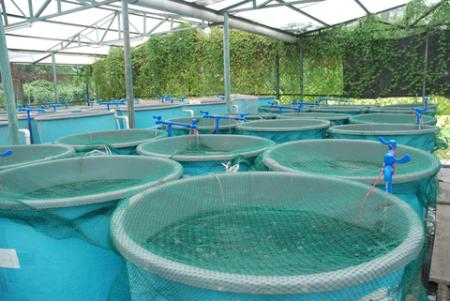| Back to Back Issues Page |
 |
|
The Goldfish Gazette, Issue #033 -- How Much Room Do I Really Need? September 30, 2016 |
Goldfish Care Tips and GuidelinesA Free Monthly Resource For Goldfish Enthusiasts In This Issue
Most of us started in this hobby with a small aquarium or bowl with one or two fish.
How Much Room Do I Really Need?
I often receive emails from readers showing images of successful spawns. This is pleasing in one respect, but sometimes I also see thousands of fry crammed into a small aquarium. You may want to breed your Goldfish to replace aging fish, or improve the quality. Whatever the reason, you need to make sure that you can look after the large numbers of fry that will be produced, without compromising the health of the few selected individuals you want to raise to maturity. Small Scale Breeding SetupThere are several stages when raising Goldfish from fry to maturity, with each stage requiring greater amounts of space, or smaller numbers of fish.Stage one is breeding: A basic breeding setup for 5 small fish with a body length of around 3 ¼” – 3 ½” would need a 4’ x 3’ pond with water 6-8” deep. The setup would have nothing in the pond except plants or breeding mops to receive the eggs. It is impractical to use the aquarium or pond the fish normally live in if you are breeding a fancy variety as many eggs will be lost, and you need to start with a reasonable number of fry. As an example, a spawn of 1500 Water Bubble Eyes may only produce 5-10 fish worth keeping. If you are breeding Common Goldfish or Comets, large numbers of fry aren’t really required as minimal culling is necessary. The fish can be bred in their usual living environment by placing spawning mops in the pond or aquarium and removing all other plant material to encourage the fish to spawn on the mops. Stage two hatching space: This doesn’t need to be very large; a 15-20 gallon aquarium will hold several thousand fry. Stage three first two weeks after hatching: The hatching aquarium can be used to raise the fry for two weeks. The maximum number of fry would be around 2000. Any more than this number would require the fry to be split between more aquariums. At the end of two weeks, fancy varieties can be culled for defective tails, (single, tri-tails, bent etc). If the quality of the fry is high, you may not reduce numbers by much, (as low as 5%), but if the quality is low, you could halve the numbers. Fry numbers should now be reduced to 200 per 15 gallons. If you don’t have the space, you need to dispose of excess fry. Fry that have already been culled for tails are more popular to enthusiasts who have the space to grow them on. Stage four: The fry need to be halved in numbers every week to ensure they are growing at maximum speed. After 3 more culls, 25 fry should be all that are left per 15 gallons and bigger individuals should be about ¾” in body length. Keep culling weekly until you are left with 20-25 fish that will require a pond or container with approximately 8 square feet of surface area and 80 gallons of water for growing over summer/autumn. Stage five: After winter and into early summer these 20-25 fish should be culled down to the 5 best fish to allow them to grow into good size fish for breeding the following spring. In Summary… To raise 5 fish to maturity from a spawning of no more than 1-2000, the minimum space required is: 1. A 4’ x 3’ x 6-8” deep spawning pond 2. A 15-20 gallon hatching aquarium/container 3. A 4’ x 3’ x 1’ deep growing pond (can be the spawning pond if deep enough). This setup will allow 5 Goldfish to be raised over 12 months if you keep reducing fry numbers weekly. To read more about how to cull fry numbers and the amount of room required to raise them click here... Comments? Ideas? Feedback? I'd love to hear from you. Just reply to this e-zine and tell me what you think, or what topics you want covered. Next Month's Topic Emergency Response For Dying Goldfishwww.facebook.com/aboutgoldfish |
| Back to Back Issues Page |